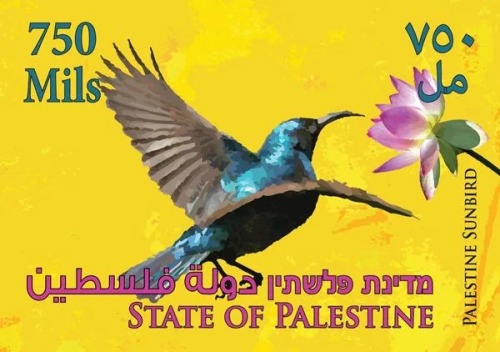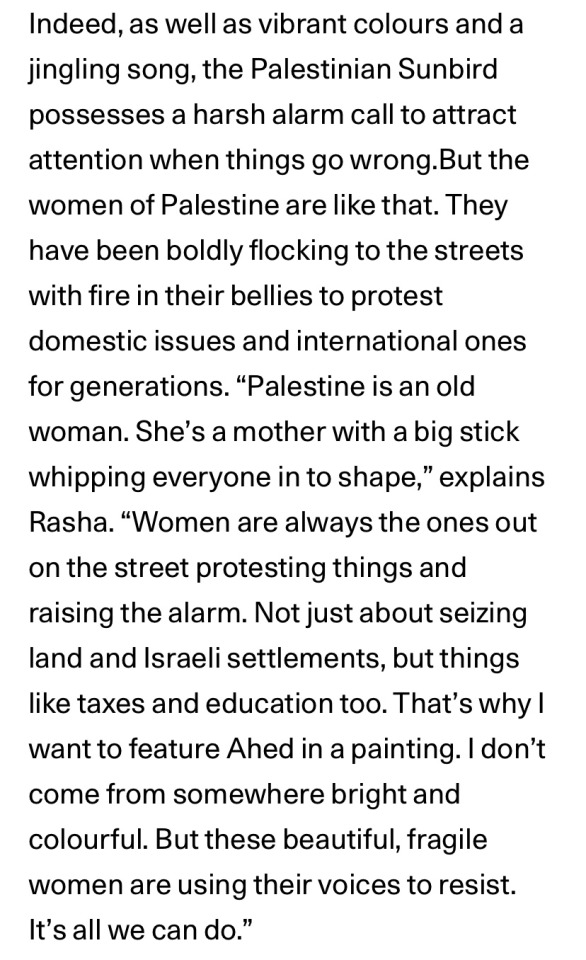Here's Some Paintings I've Done Of People Looking At Screens. These Are All Available As Prints On Inprnt:






Here's some paintings I've done of people looking at screens. These are all available as prints on Inprnt: Art Prints by Ollie Jones - INPRNT I'm also selling a limited edition print of my piece 'Producer' at Black Dragon Press: Producer – Black Dragon Press
More Posts from Lemonsharkk and Others
In order to show my support for palestine, I thought I would make a post— in typical bird nerd fashion— highlighting some information about one of the many symbols of freedom for the palestinian people: the palestine sunbird.
you’ve seen this bird everywhere lately I’m sure,
so, you may be wondering.. why is this bird so important?

In 2013, Israel campaigned to remove ‘palestine’ from the bird’s name. this failed, however, when the palestine wildlife society (PWS) petitioned to instead adopt it as palestine’s national bird as a direct defiance of the campaign.
in 2015, the palestine sunbird was officially declared the national bird of palestine.
the palestinian artist khaled jarrar designed a border control stamp featuring the sunbird with which he stamped passports as a cry for freedom.

more recently, khaled jarrar has also created these postal stamps for the same message— in defiance of israel’s efforts to erase palestine.

here you can find an incredible, short documentary detailing his work across the years to use his art as a protest against the plight of the palestinian people.

another palestinian artist, rasha eleyan, uses the sunbird in her work as a motif for the strength and boldness of palestinian women:


(source)
the palestinian poet tamim al-barghouti has tied the palestine sunbird’s beauty to resilience, in saying: “whenever you face injustice or roughness, remember to defend yourself by finding beauty… document, prove, and defend it because all beauty is resistance.”
the palestine sunbird is a symbol of hope and strength. It’s a symbol of fighting back against the odds and refusal to go quietly into the night— refusal to be erased.
continue to support palestinian artists.
continue to support palestine.
raise the voices of those who now, more than ever, need to be heard.
from the river to the sea, palestine will be free.


If you’re interested in checking out Stop!! Hibari-kun! then I recommend Hazel’s excellent video that serves as a primer to the series - https://www.youtube.com/watch?v=oa6MK_boub0
If you really like my work, you can support me at https://patreon.com/comicsbyxan and get access to works in progress, previews and extras!
Transcript:
Sometimes I just stop and think about how weird it is that Stop!! Hibari-kun! even exists. A romantic comedy where one of the leads is a trans girl would be notable even today, but this show aired in 1983, and the manga it was based on began in 1981. Stop!! Hibari-kun! is almost forty years old, and yet I’d argue that in certain ways it still hasn’t been surpassed. There have been shows that handled their trans characters better, and there have been other shows with trans protagonists (although, frankly, not very many). But Hibari herself is an utterly unique creation, and I honestly can’t think of any trans protagonist in the intervening years who could match her in brilliance and sheer badassery.
It makes for some bizarre juxtapositions because in every other sense the show is a product of the 80s, whether stylistically, in its pop culture references, or the occasional jarring racial stereotypes. There’s a fair amount of transphobia and homophobia too, which might seem at odds with what I’ve described so far, but part of Hibari’s strength is that thrives in spite of the adversity she faces.
Hibari is the daughter of a yakuza boss and is – on paper, at least – his only son and heir. The story is told mostly from the perspective of Kousaku, a boy sent to live with the family after his mother dies, and who immediately falls for Hibari but then feels conflicted upon learning that she’s trans. Make no mistake, though: Hibari is the star of the show here. She’s strong, smart and beautiful, and at school (where she’s presumed by everyone to be a cis girl), she’s a popular grade-A student with throngs of lovestruck boys – and at least one girl – falling at her feet. In another show this might come across as insincere; a low-key transphobic joke along the lines of “the most popular girl is actually a boy!” But with Hibari it doesn’t feel like that. The show’s presentation of her victories feels genuine and celebratory.
The grace with which Hibari navigates her life extends to her encounters with transphobia, too. Most of her family disapproves of her, and Kousaku’s ongoing inability to deal with Hibari’s transness often comes off as pretty hurtful. But Hibari seems unfazed by her father’s ranting and enjoys teasing Kousaku over his plainly obvious attraction to her. That’s not to say there aren’t brief moments where Hibari expresses frustration over her situation, but the narrative never lets her stay sad for long.
And I think it’s Hibari’s nigh-invulnerability – both physically and psychologically – that makes her work as a character, especially from the perspective of the trans women in the audience. In the hands of a lesser creator, Hibari could have been a figure of ridicule, but remarkably she is never a punchline, while those who mock her or try to hurt her inevitably end up as the butt of the joke. Crystal Frasier, who knows a thing or two about compelling trans protagonists, describes the show as a “transgender power fantasy”, and I think the recent resurgence of interest in Hibari has come at a time when trans women are seeking out stories where we get to be victorious.
This does return us to the question of exactly how this transgender power fantasy came to be, back in the early 80s, and at the hands of a cis creator, no less. And that’s… well, that’s a little complicated. I’ll simply say that Hibari’s creator, Hisashi Eguchi, has stated in interviews that “It is really the frustration of not being born as a girl which fuels my drawings” and leave it at that. Regardless, Eguchi has given trans audiences an icon. In a world of trans stories that focus on pain and misery, here is a protagonist who approaches her transness with joy, optimism and strength. As Hibari herself would say: “Just think of it as God’s prank.”

happy birthday to the best fictional character I know



oh to one day live in a world that doesn't hinge on the whims of the united states of fucking america.
You don't have to draw well to justify drawing, nor do you owe the world something well-drawn; the same applies to living.
The one obstacle here is the monetary incentive, to adhere to your job's idea of well-drawn, It's hard... But when artists are drawing, they rarely make this distinction, and equate the monetary worth of the drawing directly to their own worth as a person. If you claim cash is steering your art, fine, but let its impact end there. It has no right to speak on your soul.
-
 indiefoxproductions liked this · 2 days ago
indiefoxproductions liked this · 2 days ago -
 moss-brook liked this · 2 days ago
moss-brook liked this · 2 days ago -
 foxcatv liked this · 2 days ago
foxcatv liked this · 2 days ago -
 exploitedcorpses liked this · 2 days ago
exploitedcorpses liked this · 2 days ago -
 risha-png liked this · 2 days ago
risha-png liked this · 2 days ago -
 shewashonestanddonuts reblogged this · 2 days ago
shewashonestanddonuts reblogged this · 2 days ago -
 tisthefairy11-blog liked this · 2 days ago
tisthefairy11-blog liked this · 2 days ago -
 absintherust liked this · 2 days ago
absintherust liked this · 2 days ago -
 wolfie1991 reblogged this · 3 days ago
wolfie1991 reblogged this · 3 days ago -
 blackcomicbookguy reblogged this · 3 days ago
blackcomicbookguy reblogged this · 3 days ago -
 thelockeryoudontown liked this · 3 days ago
thelockeryoudontown liked this · 3 days ago -
 charlatanbacon reblogged this · 3 days ago
charlatanbacon reblogged this · 3 days ago -
 cosmic-home liked this · 3 days ago
cosmic-home liked this · 3 days ago -
 trashmanmctrasherson liked this · 3 days ago
trashmanmctrasherson liked this · 3 days ago -
 cranberrybogmummymorpheme reblogged this · 3 days ago
cranberrybogmummymorpheme reblogged this · 3 days ago -
 punk-raphaelite reblogged this · 3 days ago
punk-raphaelite reblogged this · 3 days ago -
 roosterhairschmair liked this · 3 days ago
roosterhairschmair liked this · 3 days ago -
 weroiljgre reblogged this · 3 days ago
weroiljgre reblogged this · 3 days ago -
 weroiljgre liked this · 3 days ago
weroiljgre liked this · 3 days ago -
 vassekocho liked this · 3 days ago
vassekocho liked this · 3 days ago -
 peoplespartiesbyjonimitchell liked this · 3 days ago
peoplespartiesbyjonimitchell liked this · 3 days ago -
 velvetfur reblogged this · 3 days ago
velvetfur reblogged this · 3 days ago -
 anarchafemme reblogged this · 3 days ago
anarchafemme reblogged this · 3 days ago -
 surfin-on-a-rocket liked this · 3 days ago
surfin-on-a-rocket liked this · 3 days ago -
 sky-on-blog reblogged this · 3 days ago
sky-on-blog reblogged this · 3 days ago -
 sky-on-blog liked this · 3 days ago
sky-on-blog liked this · 3 days ago -
 sizigia liked this · 3 days ago
sizigia liked this · 3 days ago -
 ebracteate reblogged this · 3 days ago
ebracteate reblogged this · 3 days ago -
 ebracteate liked this · 3 days ago
ebracteate liked this · 3 days ago -
 artfreedom reblogged this · 3 days ago
artfreedom reblogged this · 3 days ago -
 nekitella liked this · 3 days ago
nekitella liked this · 3 days ago -
 thegreatpanic liked this · 3 days ago
thegreatpanic liked this · 3 days ago -
 rottingmindatplay liked this · 3 days ago
rottingmindatplay liked this · 3 days ago -
 africanspirit-lady liked this · 3 days ago
africanspirit-lady liked this · 3 days ago -
 infinitygrids reblogged this · 3 days ago
infinitygrids reblogged this · 3 days ago -
 dykewander reblogged this · 3 days ago
dykewander reblogged this · 3 days ago -
 sangre-blanca reblogged this · 3 days ago
sangre-blanca reblogged this · 3 days ago -
 historyoftheworldiguess reblogged this · 3 days ago
historyoftheworldiguess reblogged this · 3 days ago -
 ocularskewer reblogged this · 3 days ago
ocularskewer reblogged this · 3 days ago -
 girlhaggard reblogged this · 3 days ago
girlhaggard reblogged this · 3 days ago -
 starksandsparks liked this · 3 days ago
starksandsparks liked this · 3 days ago -
 mercurialkitty reblogged this · 3 days ago
mercurialkitty reblogged this · 3 days ago -
 mercurialkitty liked this · 3 days ago
mercurialkitty liked this · 3 days ago -
 spacehomos liked this · 3 days ago
spacehomos liked this · 3 days ago -
 trevorfindsthestrals liked this · 3 days ago
trevorfindsthestrals liked this · 3 days ago -
 thatsmydepressiontm reblogged this · 3 days ago
thatsmydepressiontm reblogged this · 3 days ago -
 shenaniiigans reblogged this · 3 days ago
shenaniiigans reblogged this · 3 days ago

he/him | mostly reblogs but sometimes fanart in my art | homestuck brainrot
174 posts
